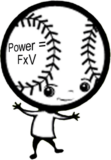Every pitcher wants his fastball to travel faster and velocity is a product of forces that are developed early on in your pitching motion and transmitted through your body to the ball. Sport science calls this the summation of forces through the kinetic chain.
The forces that are transferred through your body actually start accumulating when your stride foot hits the ground. The energy gets transferred through the foot and lower leg into the upper leg, hips and pelvis, lower trunk, upper trunk (shoulder girdle) and finally into the wrist and on to the ball.
So it’s easy to see the important role of your stride foot. Not only is it the beginning of this kinetic chain of energy, it also anchors your entire body to balance the forces that are about to be generated in the upper extremities.
In order for the stride foot to be strong and stable, the ankle and shin play an important role. The weight of the body is passed through your shin into the ankle and foot. If the shin is in the wrong position (angling too far backward from the foot) or if the ankle is rolling in or rolling out, the foot can lose its stability and the entire chain of events for your pitching motion can be affected in a negative way.
Rather than lose forces through an unstable foot, ankle, or shin, why not let the forces be with you, or should I say through you, by using the following guidelines to help you keep your fastball fast.
- Foot Position: Make sure you feel your front foot land securely on to the surface of the ground (mid-foot contact on the ball or flat-footed), not on the toe and not with the heel. Make sure when it lands, it lands straight towards the plate (like when you walk or perform a lunge) or slightly inward towards your midline. Be careful of landing too open or too closed.
- The foot and mechanics: If the foot lands too open (towards the left of a RHP), you would have had to rotate your hips too early in the stride; if the foot lands too closed (towards the right for a RHP), you will compromise the hip and pelvis rotation.
- Ankle Position: Make sure your ankle is stable; your foot shouldn’t be pronating (rolling in on the arch) or supinating (the arch lifted).
- The ankle and mechanics: Improper alignment of the ankle causes the foot to lose its position on the ground. If the foot and ankle are not secure, you can lose your entire lower body stabilization. Problems with stability during the delivery can be the cause of location issues, not to mention shoulder and elbow pain. Additionally, unnecessary motion during any part of the delivery causes forces to be dissipated that were meant for the ball.
- Shin Angle: When you land, your shin will be angled backward (knee behind heel) and as you complete your stride and begin hip rotation, your bodyweight will continue moving your knee over your foot to get you closer to the plate and create a stable base.
- The shin angle and mechanics: If when you land, your shin is angled so far backward (your knee behind your heel) that your body can’t get you over the front leg, your ankle will be in a very unstable position (extended) and you will be forced to straighten the knee. This can cause problems for a proper trunk tilt during delivery and follow-through.
- An extra note about the shin and stride: Don’t assume that your stride is too long if you have been landing too far behind your front foot. In most cases, the issue of not being able to get over the front foot and leg is more from a lack of strength from your rear leg and hip during weight shift. Remember, a longer stride gets you closer to the plate. It shouldn’t be so long you can’t manage it, but you don’t want it so short that you can’t create enough distance for ball travel.
